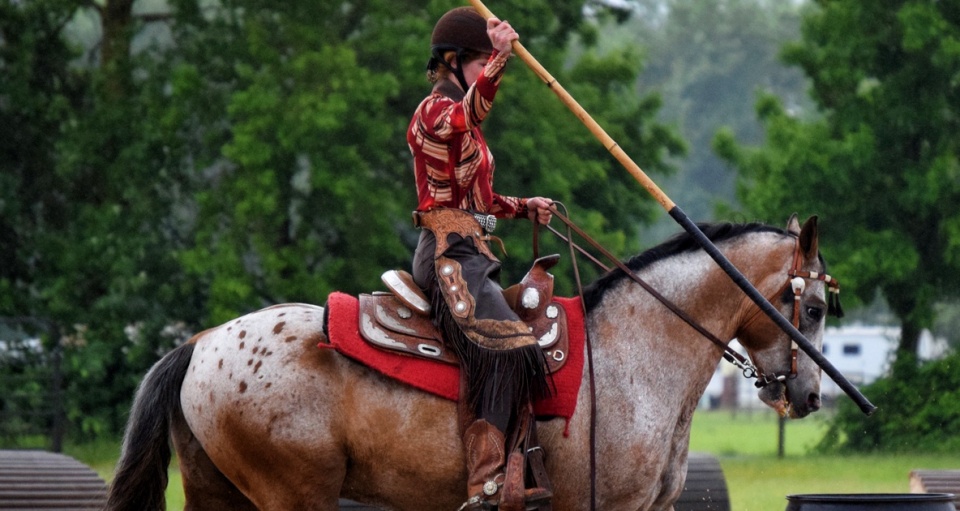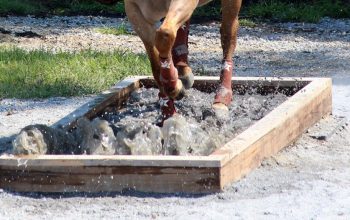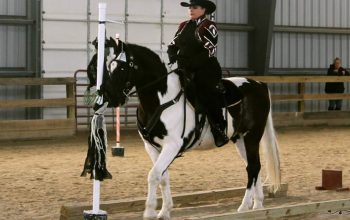
Versatility of the Sport
By Julie Alonzo
Many people are first introduced to working equitation through online videos of the master horseman from Portugal, Pedro Torres, and his magnificent Lusitano stallion Oxidado. The pair, featured on this month’s cover, have earned their popularity honestly, through the beauty of their partnership and the absolute poetry of their dance together (search YouTube for “Pedro Torres Working Equitation” if you’ve never seen this pair in action, and you’ll be mesmerized!).
Pedro’s love for Oxidado, a horse who was on the path to euthanasia because of his challenging personality before Pedro agreed to take him on and his respect for what the horse has taught him help set the tone for the sport worldwide.
Working equitation is truly a partnership between horse and rider, and one in which respect for what the horse brings to the relationship plays a critical role.

Here in North America, the rules outline a clear progression in skill and challenge as one moves from the most basic Introductory level, completed entirely at walk and trot, to the most challenging Masters level, in which horse and rider perform the equivalent of FEI-level dressage (multiple flying changes in close proximity; canter pirouettes; extended, medium, and collected gaits; reinback; and half pass), as well as working obstacles at speed and sorting cattle, all with only one hand on the reins!
In between, the sport provides carefully scaffolded building blocks, riders and their horses progress in their performance over time. This opportunity for scaffolded, supportive learning is one of the things that makes the sport so popular, but it’s not that alone.

Many riders are also drawn to the utility of the sport and the variety they encounter at working equitation competitions. That variety can take the form of different show environments – from the most classically groomed indoor coliseums with extravagantly creative obstacles (check out the photos from the Andalusian World Cup for a taste of some of the fanciest) to outdoor settings where the weather offers its own level of challenge (as a “working” discipline, competitions can be held outdoors on turf or arenas where springtime squalls can turn the entire course into a giant water obstacle).
The variety in setting and course design help keep both horses and riders fresh, as every competition offers new perspectives and such variety provides ongoing opportunities to build better communication between horse and rider. Regardless of the setting or appearance of the obstacles, however, the focus is on performing with quality bend and straightness, good rhythm, and smooth transitions. In the Ease of Handling phase of working equitation, the emphasis is on doing the obstacles with finesse rather than on “making it through” obstacles designed to intimidate less confident mounts.

Variety is also found in the types of horses and riders who participate. At the same show, it’s common to see Mustangs competing alongside Warmbloods, Quarter Horses, Arabians, Haflingers, Friesians, Andalusians, Lusitanos, Gypsies, Canadians, Paints, Rocky Mountain Horses, Appaloosas, ponies, Icelandics, Santa Cruz Island horses, Mules, Draft crosses, and grade horses of every shape and size. Riders from western disciplines, dressage courts and eventing fields flock to WE competitions, as do more casual weekend trail riders.
Above all else, though, people cite the simple fun they have at working equitation events and the supportive atmosphere where camaraderie and laughter are the norm.
Christine Righeimer, a rider from the Midwest who competes at the Novice A level, shared her thoughts about the sport after a recent competition: “Having just competed in a working equitation show this weekend…now my 4th summer showing in this awesome new sport, I can’t help but ponder why there aren’t more horse people catching on yet. This sport is truly for EVERYONE of every breed, who does any style of riding! There were Andalusians, Quarter Horses, Spotted Saddle Horses, Gaited horses and even an adorable Gypsy Vanner. I’ve seen Thoroughbreds, Haflingers, Warmbloods, Arabians…you name it! You can ride Western, English, saddle seat. You can choose your attire by discipline – I’ve even seen some really cool Portuguese and Spanish riders!
The bond that I have created with my horse Whisper over these years is like nothing I’ve ever done. I’m even a pararider who rides with two whips to replace the cues my legs can’t give. The riders, judges, volunteers and officials are always so welcoming (unlike many other disciplines I have ridden in over the years). Not only that, it is extremely affordable. You seriously just need to take a leap of faith and try it. DO NOT be intimidated! Seriously everyone there will help and support you!”
 If you find the challenge of improving your horsemanship and your partnership with your horse intriguing, and enjoy getting to know other supportive and positive horse people, I encourage you to give working equitation a try. You can find a calendar of WE events across North America on our website at www.WEUnited.us/Events. Come join in the fun!
If you find the challenge of improving your horsemanship and your partnership with your horse intriguing, and enjoy getting to know other supportive and positive horse people, I encourage you to give working equitation a try. You can find a calendar of WE events across North America on our website at www.WEUnited.us/Events. Come join in the fun!




